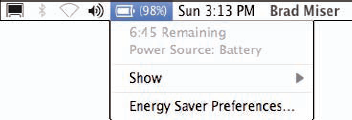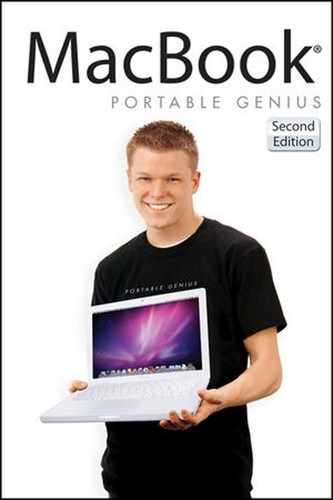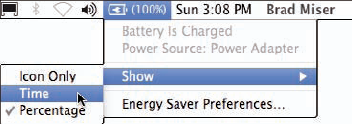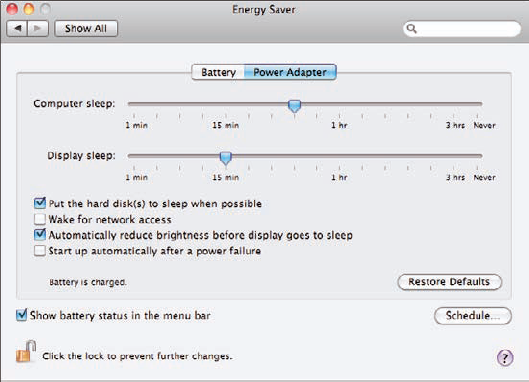
Like all devices with batteries, a MacBook can operate only as long as its battery continues to provide power; fortunately, with the current models this is quite a long time. Still, once your battery runs out, your trusty MacBook becomes so much dead weight to carry around. To get the most working time while you're mobile, you should practice good energy-management habits. These include a combination of using the Mac OS X battery management tools, conserving battery power, and being prepared to connect to an external power source whenever you have the opportunity.
Monitoring Battery Status
Making the Battery Last Longer
Powering Your MacBook while Traveling
You can use the Battery menu to keep an eye on where your MacBook power level is so that you know how much working time you have left and can take action if it's clear you are going to run out of power soon.
You can configure the Battery menu on your MacBook by performing the following steps:
Open the Energy Saver pane of the System Preferences application.
Select the Show battery status in the menu bar check box if it isn't selected already.
Open the Battery menu.
Select Show, and choose one of the following display options (see figure 10.1):
Icon Only. This displays the battery icon at the top of the menu when you are on battery power or charging the battery. The amount of the icon that is dark represents the battery's current power level.
Time. This displays the battery icon and time at the top of the menu. When you are operating on a battery, the time indicates the approximate amount of working time remaining at the current power use level.
Percentage. This displays the battery icon and the percentage of power remaining.
Note
You can check the current state of a battery by turning the MacBook over and pressing the button on the battery. The number of lights indicates the state of the battery's charge.
As you work with your MacBook, keep an eye on the Battery menu (see figure 10.2). At the top of the menu, you see the parameter you configured, such as percentage. If you open the Battery status menu, the first item is the percentage of power remaining if you selected the Time view, or the time remaining if you selected the Icon or Percentage view. You also see the current source of power, those being either Battery or Power Adapter.
When the battery gets close to being discharged, warnings appear that provide an estimate of the remaining time and recommend that you save your work. If you keep going, the MacBook eventually goes into Sleep mode and you won't be able to wake it until you connect it to a power source or insert a charged battery.

Figure 10.2. Monitor the Battery menu as you work so that your MacBook doesn't suddenly come to a grinding halt.
While it can remain in Sleep mode for a long time, a MacBook eventually runs out of even the low level of power required to keep that going and shuts off. If you have any open documents with unsaved changes, there is a slight chance they may be lost when this happens; the MacBook goes into a hibernation mode, and any open documents are saved to the hard drive, which, in most cases, will enable you to recover them as soon as you power your MacBook again. Beyond the very minor possibility of losing unsaved changes, there really isn't any risk to you to let the MacBook run completely out of power.
When you connect the MacBook to a power source, the Battery menu displays information about the charging process instead of time remaining. The battery icon contains the lightning bolt symbol to indicate that it's currently being charged. The time displayed on the menu is the time until the battery is fully charged; when it is fully or close to fully charged (mid-90 percent or higher), the battery icon contains the electrical plug symbol to show that you are operating from the power adapter.
Note
When you connect the adapter to the MacBook, its status light is amber when the battery is charging. When fully charged, the status light turns green.
You can use the Energy Saver to minimize power use while operating on battery power. You can also adopt simple practices to minimize the amount of power your MacBook uses so that you get the most time possible from its battery.
Use the Energy Saver pane of the System Preferences application to tailor how the computer uses power so that you can extend the working life of the battery as long as possible. There are two basic ways to configure power usage on a MacBook: You can use the default settings, or you can customize your settings. You configure settings for operating on battery power and for operating on the power adapter. Once your settings are configured, the MacBook automatically uses the settings for the power source you are currently using.
Use the following steps to set up your MacBook for minimum energy use and maximum working time:
Open the Energy Saver pane of the System Preferences application.
Click the Battery tab to configure energy use while operating on battery power (see figure 10.3).
Use the top slider to control the amount of inactive time before the entire system goes to sleep. The MacBook uses the least amount of power when it is asleep, using only slightly more than when it is shut off. Of course, it wakes up a lot faster than it starts up so sleep is a good thing. You want to set a time that conserves power, but that doesn't go to sleep so frequently that it interrupts what you are doing.
Use the bottom slider to set the amount of inactive time before the display goes dark. The display is one of the highest drains on your battery's power so you can extend your battery life by having the display sleep after shorter periods of activity. Of course, if it goes to sleep too quickly, it can be intrusive and annoying so you need to find a good balance between these effects.
In most cases, you should leave the Put the hard disk(s) to sleep when possible check box selected. If you notice that you have to pause frequently when what you are doing has to save data to the hard drive, try deselecting this check box.
Select the Slightly dim the display when using this power source check box if you want your display to have a lower brightness when operating on the battery. Dimming causes the screen to go to a lower brightness setting before the display sleeps (when it goes totally dark). In my experimentation, it appears that this function reduces screen brightness by about two ticks on the brightness indicator.
Select the Automatically reduce brightness before display goes to sleep check box if you want your display's brightness to be reduced automatically before it goes to sleep. This saves a little power but is more useful because you have some warning before the MacBook goes to sleep.
Click the Power Adapter tab. You see slightly different options in the pane (see figure 10.4).
Configure the settings like you did for operating on the battery. Usually, you are less concerned about saving energy when you are operating on the power adapter so you can extend sleep times to prevent interruptions.
Select the Wake for network access check box if you want the MacBook to wake up when network activity is detected. (This setting replaces the Automatically dim display setting for battery power option.)
Select Start up automatically after a power failure if you want your MacBook to start up after it has lost power. This setting is more applicable for desktop Macs because your MacBook has a battery. However, if the power remains out so long that the battery is completely drained, your MacBook will automatically restart when power is restored.
Note
To return the energy configuration to what Apple considers optimal for most users, click Restore Defaults.
Note
If the MacBook's lid is shut, the schedule has no effect.
Although configuring the energy use of your MacBook has some impact on how long you can operate it on its battery, you can also adopt low energy habits to maximize the amount of time your MacBook operates on its battery. Here are some ideas to consider:
Lower the brightness of your display. Because it is one of the higher demands on your battery's power, you want to set your display's brightness at the lowest brightness level that is still comfortable to see to maximize battery life. To dim your screen, use the Brightness slider on the Displays pane of the System Preferences application, or press F1 to decrease it or F2 to increase it.
Set automatic brightness adjustment. Open the Displays pane of the System Preferences application and ensure Automatically adjust brightness as ambient light changes is enabled. This automatically dims the display in lower-level light conditions and increases it in brighter conditions. If you use the MacBook in bright conditions for an extended period, you might want to disable this and instead manually set the brightness level to the dimmest you can tolerate.
Avoid applications that constantly read from the hard drive. While you probably won't have much choice on this, some applications have settings that impact hard drive use, such as autosave features (you can increase the amount of time between automatic saves to reduce hard drive use, and thus energy use).
Avoid applications that constantly read from a CD or DVD. If you can copy files you need onto your hard drive and use them from there, you use power at a lower rate than if your MacBook is constantly accessing its removable media drive. For example, when you want to listen to music or watch movies, you can add the content to your iTunes library so you don't need to use the CD or DVD drive.
Use an iPod. Playing content in iTunes requires a lot of hard drive activity and is a heavy user of battery power. Using an iPod for these tasks saves your MacBook for the tasks you can only do on it.
Put your MacBook to sleep whenever you aren't actively using it by closing the lid. When you open the lid or press a key, the MacBook wakes up quickly, so putting it to sleep frequently doesn't cause a lot of wasted time for you.
If you are traveling for a long period of time, the odds are good that you're going to run out of battery power, even if you have tweaked your MacBook for maximum operating time and you practice low energy habits. You can reduce the chances of running out of power by being ready to power your MacBook while you are on the move.
Note
Most airports have power outlets available in the gate areas, but they aren't always obvious to see and can be hidden by chairs or other obstacles. Some airports have charging stations that are a handy way to top off your MacBook's battery.
Following are some recommended items that can help you manage your power on the move:
Standard power adapter. Whenever there's a power outlet available, you can use the included adapter to run the MacBook and to charge its battery.
MagSafe Airline Adapter. With this adapter, you can connect your MacBook to the power outlet that is available in some kinds of seats on airlines. The requirement is that the seat must have an EmPower or 20mm power port.
International adapters. If you travel internationally, get a set of power adapters so that you can connect the MacBook power adapter to power outlets in a variety of countries.
Warning
While the airline adapter looks like it might be compatible with the DC power port in automobiles, it isn't.



